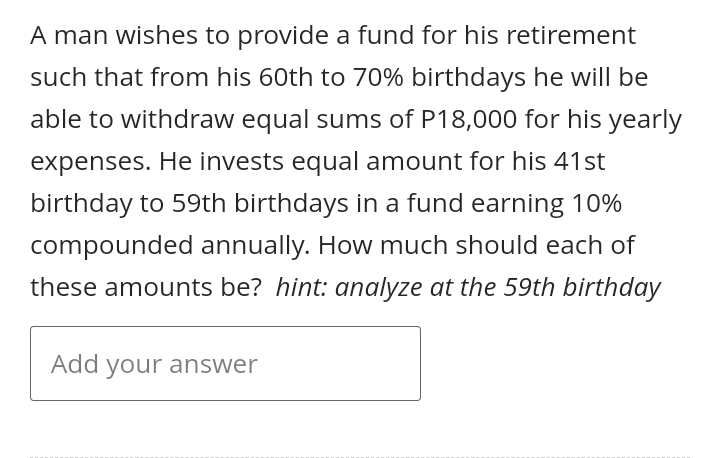A man wishes to provide a fund for his retirement such that from his 60th to 70% birthdays he will be able to withdraw equal sums of P18,000 for his yearly expenses. He invests equal amount for his 41st birthday to 59th birthdays in a fund earning 10% compounded annually. How much should each of these amounts be? hint: analyze at the 59th birthday
A man wishes to provide a fund for his retirement such that from his 60th to 70% birthdays he will be able to withdraw equal sums of P18,000 for his yearly expenses. He invests equal amount for his 41st birthday to 59th birthdays in a fund earning 10% compounded annually. How much should each of these amounts be? hint: analyze at the 59th birthday
Chapter4: Economic Evaluation In Health Care
Section: Chapter Questions
Problem 7QAP
Related questions
Question
10. Please use the formula to solve the problem
![Legend:
Cc - Capitalized Cost (Currency)
Fc - First Cost (Currency)
Mc - maintenance Cost (Currency)
Rc - Replacement Cost (Currency); if no Re: Re Fe
Sy- Salvage Value (Curency); if no Sy: Sy = 0
A - Periodic Amount (Currency)
F-Future Value (Currency)
G - Periodic Amount Increment Amount (Currency)
P - Present Value (Currency)
g - Periodic Amount Increment Rate (Persentage)
i-Nominal Interest Rate (Percent)
m - Number of Periods per Year (Number)
r - Effective Interest Rate (Percent)
t-Number of Years (Number)
Formulae:
Compounding Transformation (i, (m₂)→ 1₂ (m₂)): (1 + ) = (1 +)**
Perpetuity (t=00):
Ordinary Annuity (Payment at End of Period):
P=A1-(1+1)-²)
Arithmetic Gradient:
Geometric Gradient:
Capitalized Cost:
n = mt
Annuity Due (Payment at Beginning of Period):
r=-
m
F = P(1+r)"
P = F(1+r)-R
F=A
F=A
= A ((1+r)^²-1)
F=
P=A (1-(1+r)^)(1+r)
= A (¹ + r)² - 1) (1 + r)
T
FA[(1+r)-1]G[-nr + (1+r)" - 1]
T
r2
A[(1+r)"-(1+g)"]
T-9
Rc-Sv
Cc=Fc++ (1+r)"-1
A = Cer](/v2/_next/image?url=https%3A%2F%2Fcontent.bartleby.com%2Fqna-images%2Fquestion%2F7053b554-3a97-4d68-beed-d147b9a2b76e%2Fce7252c2-3065-4e46-b062-2cc688dd5aaf%2F7kigzr5_processed.jpeg&w=3840&q=75)
Transcribed Image Text:Legend:
Cc - Capitalized Cost (Currency)
Fc - First Cost (Currency)
Mc - maintenance Cost (Currency)
Rc - Replacement Cost (Currency); if no Re: Re Fe
Sy- Salvage Value (Curency); if no Sy: Sy = 0
A - Periodic Amount (Currency)
F-Future Value (Currency)
G - Periodic Amount Increment Amount (Currency)
P - Present Value (Currency)
g - Periodic Amount Increment Rate (Persentage)
i-Nominal Interest Rate (Percent)
m - Number of Periods per Year (Number)
r - Effective Interest Rate (Percent)
t-Number of Years (Number)
Formulae:
Compounding Transformation (i, (m₂)→ 1₂ (m₂)): (1 + ) = (1 +)**
Perpetuity (t=00):
Ordinary Annuity (Payment at End of Period):
P=A1-(1+1)-²)
Arithmetic Gradient:
Geometric Gradient:
Capitalized Cost:
n = mt
Annuity Due (Payment at Beginning of Period):
r=-
m
F = P(1+r)"
P = F(1+r)-R
F=A
F=A
= A ((1+r)^²-1)
F=
P=A (1-(1+r)^)(1+r)
= A (¹ + r)² - 1) (1 + r)
T
FA[(1+r)-1]G[-nr + (1+r)" - 1]
T
r2
A[(1+r)"-(1+g)"]
T-9
Rc-Sv
Cc=Fc++ (1+r)"-1
A = Cer

Transcribed Image Text:A man wishes to provide a fund for his retirement
such that from his 60th to 70% birthdays he will be
able to withdraw equal sums of P18,000 for his yearly
expenses. He invests equal amount for his 41st
birthday to 59th birthdays in a fund earning 10%
compounded annually. How much should each of
these amounts be? hint: analyze at the 59th birthday
Add your answer
Expert Solution
This question has been solved!
Explore an expertly crafted, step-by-step solution for a thorough understanding of key concepts.
Step by step
Solved in 4 steps

Knowledge Booster
Learn more about
Need a deep-dive on the concept behind this application? Look no further. Learn more about this topic, economics and related others by exploring similar questions and additional content below.Recommended textbooks for you

